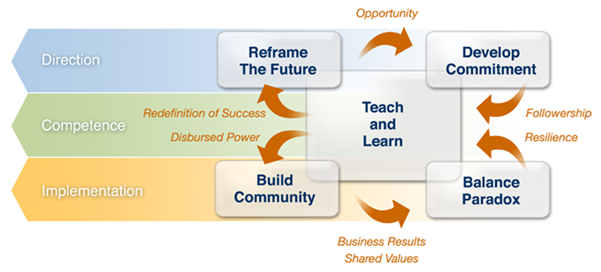ATD Blog
Strategic Leadership Tools: What You Need in Your Toolbox
Fri May 21 2021

Bookmark
In the previous blog post, we explained why leaders need tools to help them do their work. In this post, we describe the nature of these tools and give some examples.
A leadership tool is a prescription for how to go about specific types of leadership work, using proven, step-by-step practices and leadership skills that are based on solid organization concepts helpful to more expediently address certain types of organization, leadership, and management issues. The tools are helpful for strategic thinking, communications planning, emotional intelligence, working through highly multifaceted issues, and the execution of complex objectives.
The systematic use of tools contributes to a leadership development process that helps a leader move individuals, teams, and whole organizations toward success, which helps leaders help others achieve the organization’s strategic goals. And that helps everyone learn how to learn.
It’s the sequence of applications that create effective leadership styles so the leaders can manage and focus their time, helps people think strategically, helps leaders with problem solving, builds cross-organizational alliances, and addresses issues for which there are no easy answers. (See the table below for a classification for the types of work and tasks for which tools are used).
Table 1: Types of Organization Work, Related Tasks, and Examples of Tools Employed
Types of work | Related tasks | Examples of tools |
Organizing people and tasks | Concepts, models, frameworks to better understand what is taking place | Glenda Oyong: Chaos theory Michael Porter: Strategy Chris Argyris: Interpersonal dynamics Barry Oshry: Functioning in hierarchy Clay Christianson: Innovation Ronald Heifetz: Leadership work |
Leadership work | Set goals, build framework for change, develop organizational capacity to implement the change, execute the plan | Scenario planning Polarity mapping Story telling Six communications questions Core organization competencies RAPID decision making Six A’s for learning |
Management work | Hire/fire, allocate resources, address short term problems, provide performance feedback | Budgets for department/division objective setting, performance management LEAN/Six Sigma Time management tools |
Developing individual leader capabilities | Assess and improve critical individual leader skills | Individual assessments Personality assessments Coaching Individual development planning |
|
Leadership tool example
There are hundreds of thousands of books, studies, and articles that provide leadership advice and insight. Yet, in practical terms, the vast majority of organizations continue to struggle in planning, improving organization competence, and the execution of change.
Just as manufacturing and service organizations have learned to use LEAN and Six Sigma methods to facilitate product quality, we believe leaders can similarly use leadership tools to more easily manage risk, improve communication efficiency and effectiveness, and improve the speed of strategic execution.
One example of a strategic leadership tool is “The Leader’s Map,” which demonstrates how leadership can be practiced as a describable, teachable, repeatable, measurable, and institutional process. Rather than seeing change as a unique event or based on the competencies of a few leaders, change can be understood as an almost predictable, recurring set of circumstances that can be anticipated, described, and thus easily executed across internal and external organizational boundaries.
The tool is scalable, and can be used by senior leaders, as well as first line supervisors. The use of standard practical leadership language and process provided by the tool offers a structure to do the full range of leadership work. It increases collaboration, embeds the change within the cultural fabric of the organization, and provides a vehicle for action learning to take place.
Using The Leaders Map™ (see Diagram 1) facilitates the implementation of change because the impetus no longer needs to reside with senior leaders alone. It now can become a more significant competency that resides within middle management. This frees senior leaders to more effectively concentrate on the true strategic issues. The competence of middle managers to do this work leads to higher levels of employee engagement and the ability of managers to achieve the organization’s longer term financial and strategic objectives. The tool gives middle managers and senior leadership a common language and structure for executing change.
Diagram 1: The Leader’s Map™

Using The Leader’s Map™ helps leaders understand that:
There are five universal challenges that must be addressed in every strategic initiative: 1) reframing the future, 2) developing commitment, 3) teaching and learning, 4) building community, and 5) balancing paradoxes.
There are three outputs of leadership (direction, competence, implementation) that can be used to evaluate leadership effectiveness.
To be successful, change must be addressed in a specific order.
Leadership requires high levels of collaboration across organizational boundaries.
There are additional tools that can help people work through the five challenges.
Difference between management tools and leadership tools
Management work is about creating stability, to ensure the organization achieves its stated goals. Examples of management tools are steps in how to complete a performance appraisal, how to provide individual coaching, and how to interview job candidates. Most organizations have effective programs in place that help people develop the kinds of skills needed to adequately perform management work.
Leadership tools help people think strategically, more effectively work across organization boundaries and competing priorities, plan and monitor complex execution, and address challenges for which there are no easy answers. It is in this area that most internal training initiatives have failed to adequately prepare mid to senior level leaders to address the challenges before them.
This blog post was originally published in February 2014 but has since been updated with new information and resources.
More from ATD





